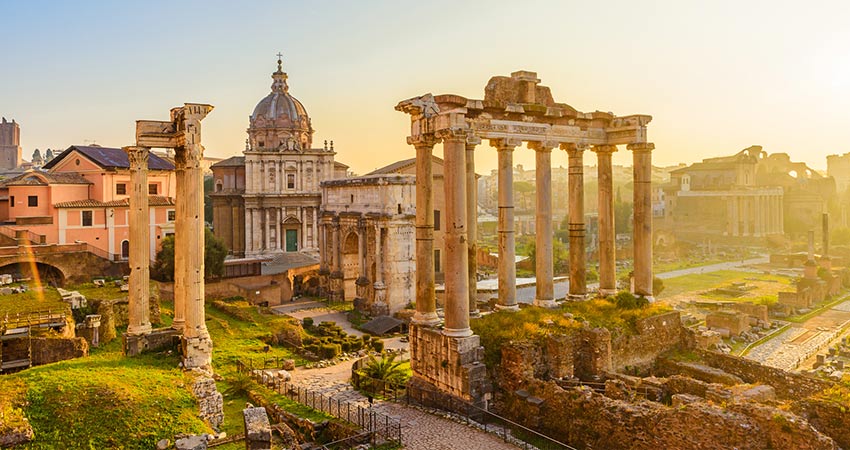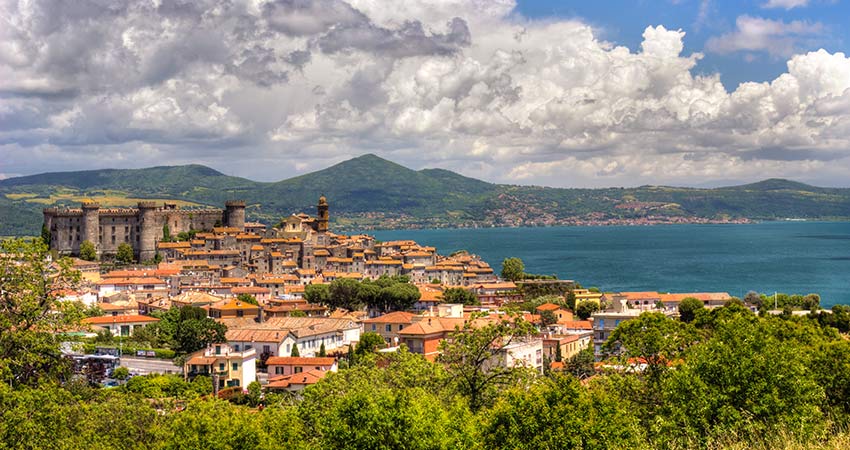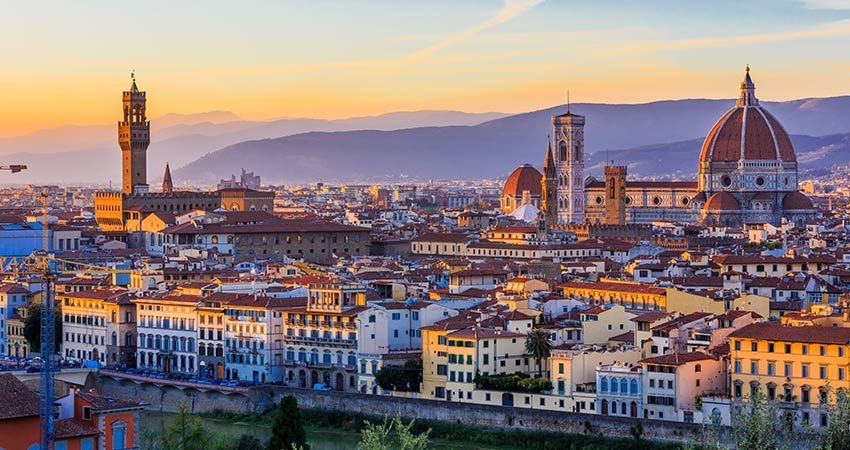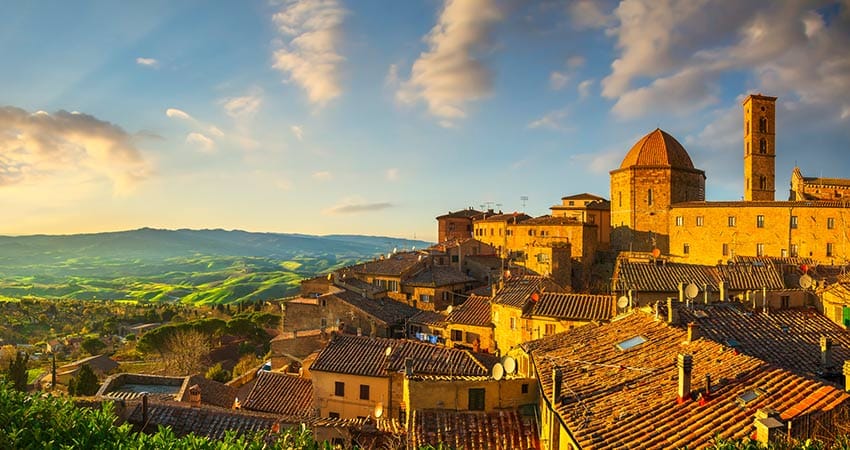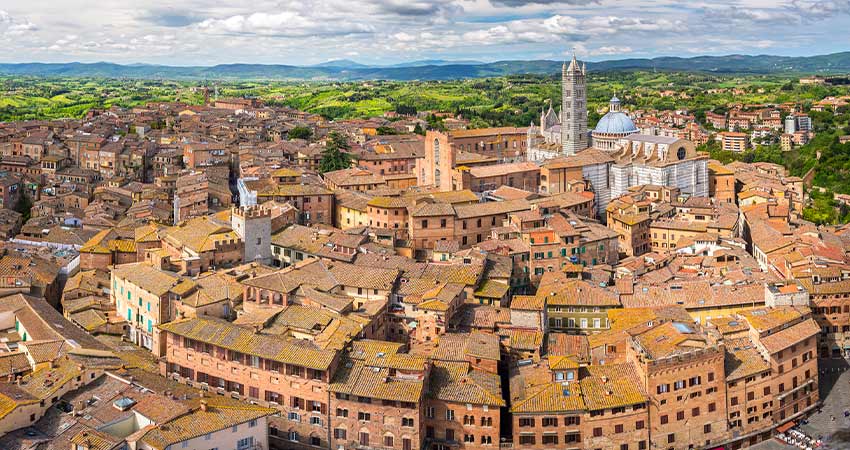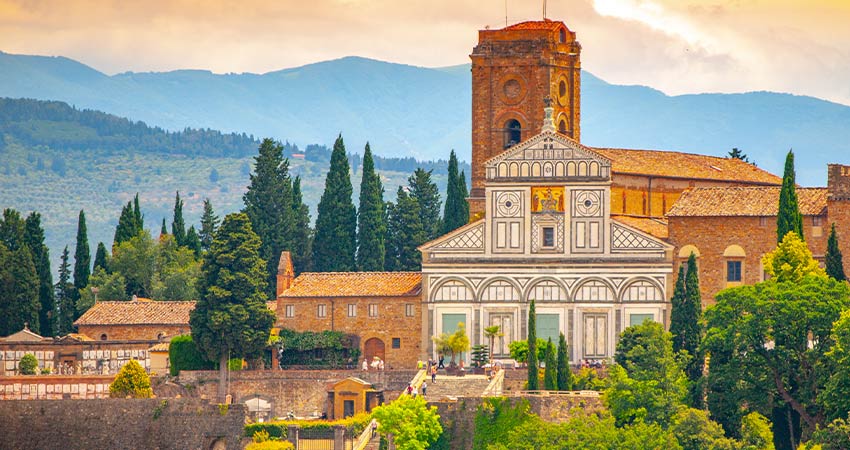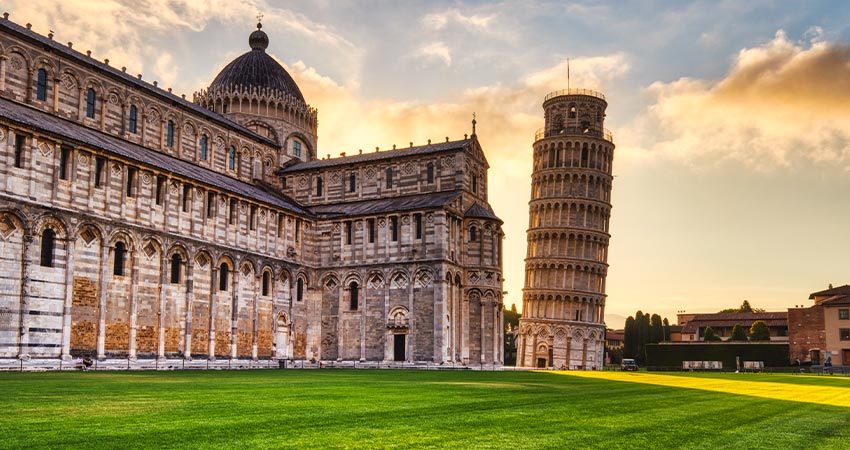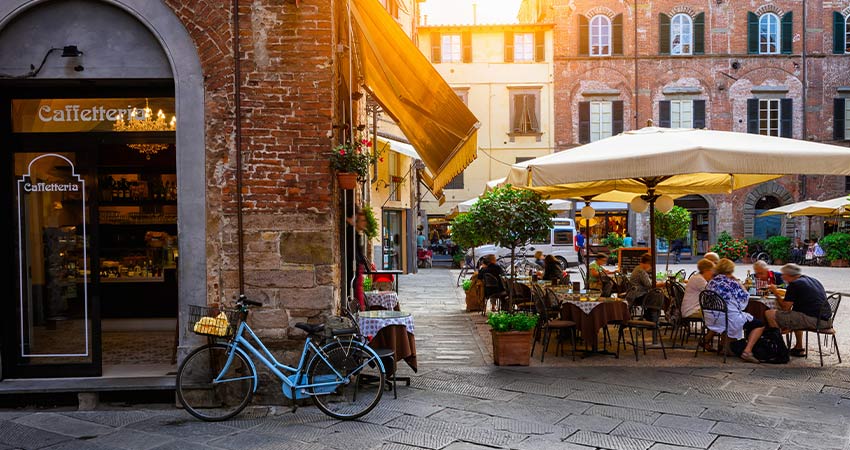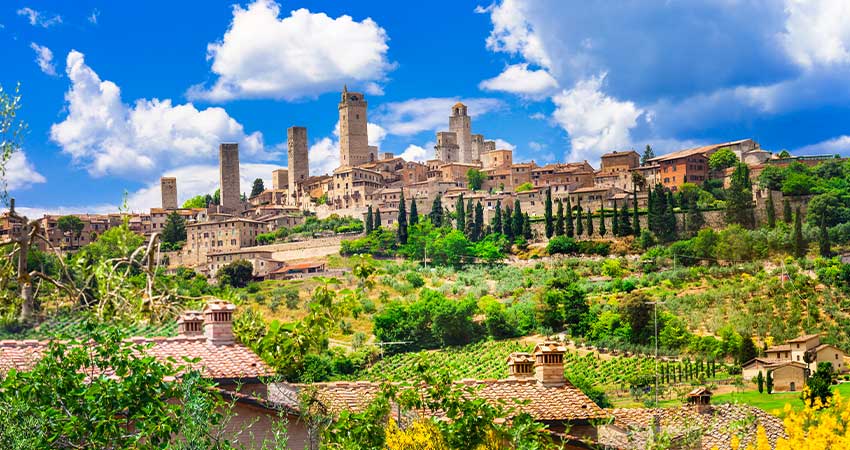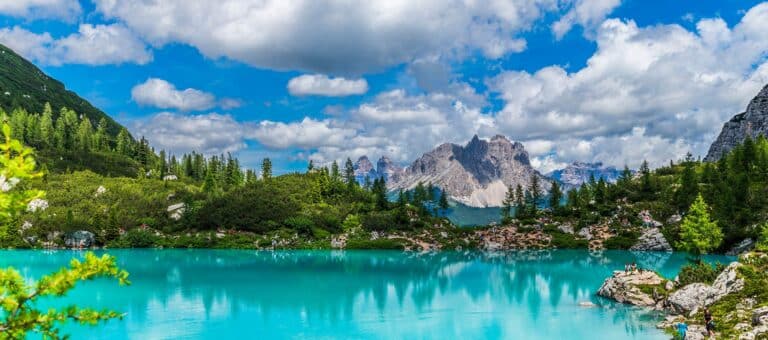Traveling through the major cities of Central Italy, which includes Rome and Florence, is a journey through Western Civilization. This is a region of incredible geographical and cultural diversity. From rugged mountain peaks to rolling hills and lush valleys, historic sites abound. This area is also known for its cuisine; it’s the home of Balsamic vinegar, prosciutto, cheeses, seafood, and gelato. Its regions include Lazio, Marche, Umbria, Tuscany, and Abruzzo, and all are beautiful. Following is a list of some favorite places.
Rome
The Roman Republic began in 509 BC and its culture soon dominated the Western World. By 100 AD it had a population of 1.5 million and was the de facto capital of the world. By the 6th century Rome was in chaos, and the Catholic Church stepped into the vacuum.
Today, the ancient center of Rome is home to the Colosseum, the Roman Forum, and the Palatine Hill. (The forum is particularly atmospheric in the evening.) The Palatine Hill is the center of the seven hills of Rome and is called the “first nucleus of the Roman Empire.” This is a cool, shady spot, dotted with pines, and has an incredible view of the city.
The area around the Piazza Navona is the social heart of the city. There are outdoor cafes, people selling crafts, cobblestone streets with hidden churches and shops, Bernini’s Four Rivers Fountain, and the glorious Pantheon. Northeast Rome is a shopper’s dream. It’s also the place to toss a coin in the Trevi Fountain and witness the wonder of the Santa Maria Maggiore church. Slip into a trendy café and watch the river of people pass by.
The Vatican is a must for pilgrims of every sort. St. Peter’s, the Sistine Chapel, and the extraordinary collection of the Vatican sometimes leaves a traveler speechless. The nearby Piazza San Cosimato is filled with shrines of the Madonna, protecting all those who pass by. Southwest of Palatine, the Aventine Hill is a pleasant retreat. This is a quiet, middle-class neighborhood that is dotted with ancient churches, villas, and shady trees.
Bracciano
A small town just 19 miles northwest of Rome, Bracciano is known for its gorgeous volcanic lake. Called Lago di Bracciano, or Sabatino, it’s the 8th largest lake in Italy, and a beautiful place to sail and swim. The medieval castle, Castello Orsini-Odescalchi, is lovingly preserved. The Orsini’s were a noble Roman family, and since the castle was built, it has been owned by several powerful families. Today it is open to the public, and you can see more than twenty rooms, complete with original furnishings from the Renaissance period. There are frescoes, carved chests, beds, closets, and breathtaking views of the lake. One of Michelangelo’s disciples worked in this castle, adding touches from the master.
While in Lake Bracciano, head to Gelateria Picchio. Just a short walk from the castle, the gelato here is some of the best in Italy. Try one of their outrageous flavors! There are beach clubs with cafes, restaurants, and showers. If you want to experience the longest beach on the lake, rent a lounge and an umbrella and go to Vigna di Valle beach. Gorgeous.
Florence
Florence is the capital of Italy’s renowned Tuscan region, and the center of Renaissance art. The Duomo, a cathedral with a bell tower, is instantly recognizable. The Galleria dell’ Accademia has Michelangelo’s “David.” The Uffizi Gallery is the home of Botticelli’s “The Birth of Venus,” as well as two Leonardo da Vinci paintings. Those are the highlights, but there is elegant beauty, and a few surprises, around every corner.
One of those surprises is the Officina Profumo Farmaceutica. Opened in the 13th century, slip inside this Gothic structure for a world of perfumes and unique wellness products. San Niccolò is the place for an opulent shopping experience, whereas the Piazza del Mercato Nuovo is an open-air market with a heady mix of food, handcrafted leather, and arts from around the city.
The Pitti Palace, once home of the powerful Medici family, has an exceptional museum, the Palatine Gallery, with a treasure of 16th and 17th works of art. Inside the Silver Museum you’ll see a collection of Medici household items, ranging from silverware to jewelry. On the top floor, you’ll find the Gallery of Modern Art. The family’s Boboli Gardens is known as “the green lung of Florence.” It is a peaceful retreat, and a work of art that can stand alongside any created with paint and brush.
Tuscany is, of course, foodie heaven, and the heart of the Tuscan region is Florence. Wander through the center of town and find stalls serving a panino with salsa verde, a juicy herb sauce. The best places for street food are in the Piazza Mercato Nuovo, the Mercato Centrale, and the Piazza dei Cimatori. It’s in these places that the scent of fresh bread fills the air, local cheeses are abundant, wine bars are beautiful, and the produce is extravagant. Of course, there are also restaurants with some of Italy’s top chefs, creating exceptional contemporary cuisine. Traditional Florentine food is hearty and includes steaks, panzanella (tomato onion, and dry bread salad), and crostini. Indulge.
Volterra
Just southwest of Florence, the hillside town of Volterra has winding lanes and the remains of Etruscan walls. As a matter of fact, the Museo Etrusco Guarnacci has one of the finest collections of Etruscan artifacts in Italy—stop in. The Palazzo dei Priori is the oldest seat of government in Tuscany. Building was started in 1208, and you’ll see 14th century frescoes inside plus a bell tower with astonishing views. The Pinacoteca e Museo Civico is an excellent art gallery and museum. The Roman Theater complex includes ruins of 3rd century baths.
Volterra has long been known for its artisans and artists. Famous for alabaster, this is the place to buy Tuscan art and handcrafts. The town is known for its locally mined alabaster, and for 2,500 years craftspeople here have been carving and sculpting it into wondrous shapes.
Siena
The Piazza del Campo is one of Europe’s greatest medieval squares and is situated in the heart of Siena’s contrade, or parishes. The 17 animals represented by each parish are found on flags, down hidden alleys, and on plaques and carvings throughout the city. This loveliest of Italian piazzas is the site of an old Roman forum.
Hillside Siena’s highest point is the Duomo. When inside this amazing green-and-white Gothic Cathedral, look up. The sculpted heads of 172 popes look down upon all who enter. Michaelangelo statues and Bernini sculptures are inside, as well as a carved pulpit crafted in 1268. Saunter through the city’s lanes and savor the Sienese food specialties of gourmet pasta, boar prosciutto, olive oil, and panforte, a chewy dessert with nuts and fruits. All pair perfectly with the local Chianti.
San Miniato
A perfect little village between Florence and Pisa, San Miniato sits high in the Arno Valley. This is a quiet, enchanted town with breathtaking views. Known by the Romans as Quarto, this entire area grew in size until it was swallowed up by Florence. It was a lookout for the valley, situated on three prominent hills near the Arno River. From these hills, you can see the ports along the center of the Italian peninsula and also the route between France and Rome.
The fortified towers still stand. The town’s Rocca, or fortress, was built between 1217-1223, and was used to keep an eye on movement in the valley. The ancient arts and skills of truffle hunting and leatherwork are very much alive here. Truffle hunting begins in the woods with a master truffle hunter and his dog, trained to have an uncanny ability to find the precious truffles.
Pisa
We recognize Pisa, also in the Tuscany region, for its leaning tower. Already tilting when it was completed in 1372, the 184 ft, white-marble Romanesque bell tower is next to the cathedral in the Piazza dei Miracoli. You can climb 297 steps to the top of the tower for great city views. Also in the piazza is the Baptistry; its renowned acoustics are demonstrated by musicians and singers—go for it! This spectacular city has ancient churches, palaces, and lovely Italian squares. The Piazza dei Miracoli, or Square of Miracles, is a designated UNESCO world heritage site.
After exploring the old streets, stroll along the Arno river—the backdrop is majestic mountains. Stop into the Gelateria De’ Coltelli, on the banks of the Arno, for exotic gelato flavors—this is a must. Borgo Stretto is ideal for shopping. Take your time and notice the townhouses, painted in pinks and colors of the earth, and watch laundry flapping on the lines. The remains of a Roman aqueduct runs by the Parco Don Bosco, a perfect picnic spot. And every café has its own version of traditional Tuscan soup and focaccia.
Lucca
Just about everyone falls in love with Lucca. Tucked within impressive Renaissance walls, its cobblestone streets, shady squares, and promenade makes it a perfect city to explore on foot. Broad, tree-lined pathways along the tops of these massive 16th- and 17th-century walls are popular for strolling and cycling. Situated on the Serchio River, Lucca is on a fertile plain near the Ligurian Sea.
Lucca is an Italian “Città d’arte,” or City of Art. Settled by the Etruscans, the Piazza dell’Anfiteatro originated in the second half of the 1st century A.D., and the 150 ft. Guinigi Tower dates from the 1300’s. The Piazza San Michele is on the site of an ancient Roman forum. At the Lucca Conference, in 56 BC, Julius Caesar, Pompey, and Crassus affirmed their alliance as the First Triumvirate.
Lucca became prosperous in the 11th century, competing with Byzantium in the silk trade. Lucca wove silk fabrics shot through with gold or silver threads. The city is also the birthplace of numerous world-class composers, including Giacomo Puccini. Buy fresh focaccia, grab a bottle of Lucchesi wine, and have a picnic on top of Lucca’s walls! Get ready for theatrics as people dressed in full costume perform atop the walls, or go hear one of Puccini’s operas. It’s the end of a perfect day.
San Gimignano
Originally an Etruscan village, this enchanted rural town is where time stands still. Southwest of Florence, in Tuscany, it is surrounded by 13th century walls. The Piazza della Cisterna is the center of San Gimignano’s old town Cisterna; it is a triangular plaza lined with medieval houses. The skyline here is punctuated with medieval towers, including the stone Torre Grossa. The Duomo di San Gimignano is a 12th-century church with frescoes by Ghirlandaio.
The middle of this city is a UNESCO world heritage site, and is an ideal example of medieval architecture with influences of Florentine, Sienese, and Pisan styled from the 12th to 14th century. While only 14 of the original tower houses have survived, San Gimignano has retained its feudal atmosphere and appearance. Look for cozy wine bars in the heart of the city, and savor cold meats, cheeses, brusche, seasonal soups, and luscious local wines.
Touring Central Italy, particularly Rome, Florence, and Tuscany, is diving inside the story of a nation, the cuisine, the art, and the cultures that were born here. Visiting this region often feels as if you’re returning home.
When you’re ready to discover the heart and soul of Italy, let your Destination Expert know!


